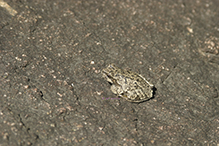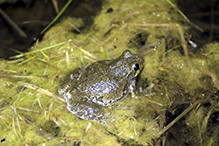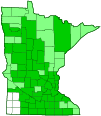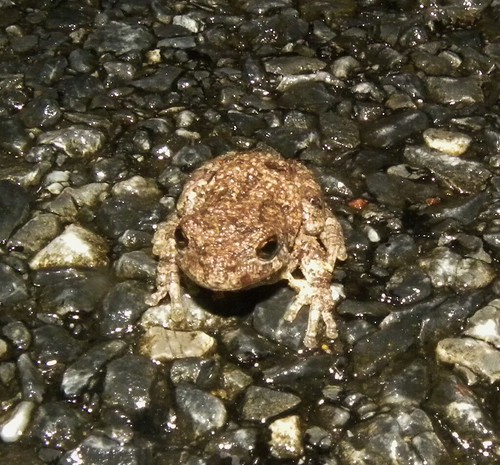Cope’s gray treefrog
(Dryophytes chrysoscelis)
Conservation • Description • Habitat • Biology • Distribution • Taxonomy
Conservation Status |
|
|||||||
| IUCN Red List | LC - Least Concern |
|||||||
| NatureServe | N5 - Secure S5 - Secure |
|||||||
| Minnesota | not listed |
|||||||
Description |
||
Dryophytes is a genus of small treefrogs. Only two species occur in Minnesota, gray treefrog and Cope’s gray treefrog. The two species are almost identical in appearance, and are difficult to tell apart in the field, even by experts. The most reliable ways to distinguish between them is by listening to their calls or examining their chromosomes under a microscope. However, the chromosomes are normally invisible under a light microscope. They become visible only when the cell duplicates. Cope’s gray treefrog is a small, solitary, nocturnal frog. It is 1¼″ to The upper (dorsal) surface is warty. It may have blotches but often does not. If there are blotches then the blotches are usually not outlined in black. The background color can change in seconds from green, light grayish-green, gray, brown, or dark brown. The color is determined by the color of the background, the season, and the humidity. It is most often some shade of gray. There is usually a large, irregular, dark blotch on the back. Beneath each eye there is a small spot. The spot is white or another light color, and it may be prominent or obscure. The belly is white. On females the chin is pale olive-gray. On males the chin is darker gray. The toes end in large adhesive pads. On males, the lower (ventral) side of the hind legs is bright yellow or yellowish-orange. |
||
Size |
||
1¼″ to |
||
Voice |
||
A fast trill lasting 1 to 3 seconds, not varying in pitch |
||
Similar Species |
||
Gray treefrog (Dryophytes versicolor) is almost indistinguishable morphologically. The dorsal surface is rougher and usually blotched. The blotches are outlined in black. The call of gray treefrog is a slower trill with about half as many notes. They prefer more wooded habitats. |
||
Habitat |
||
Forest edges, prairies, oak savannas, areas near permanent or temporary waters. Near street lamps and lighted buildings at night. |
||
Biology |
||
Behavior |
||
Adults are usually found high in trees, on mossy or lichen-covered fences, or sometimes in abandoned bird houses. They are rarely found on the ground except in breeding season. During breeding season the adult’s background color is usually green. |
||
Lifespan |
||
Unknown. Probably 5 to 7 years. |
||
Life Cycle |
||
Breeding occurs from April to July, peaking in May to June. After breeding, the female will deposit 450 to 600 packets of 30 to 40 eggs each on emergent vegetation at the surface of a shallow pond or a permanent or temporary pool. The eggs hatch in about three weeks and metamorphosis occurs about four weeks later. The tadpole is about 2″ long preceding metamorphosis. Adults overwinter under the shelter of a log, rock, bark, or leaf litter. They are freeze tolerant and can survive multiple freeze-thaw cycles. Glycerine is produced preventing the formation of ice crystals in vital organs. They live 5 to 7 years. |
||
Tadpole Food |
||
Algae, material from dead and decaying plants and animals (detritus). |
||
Adult Food |
||
Insects, insect larvae, mites, spiders, plant lice, harvestmen, snails, and smaller frogs. |
||
Distribution |
||||
|
Sources 4, 14, 24, 29, 30, 60, 73, 76, 78. The counties in lighter green represent distribution data from the USGS National Amphibian Atlas (60) that does not occur in any of the other sources in the link list above. This may represent the species geographical range rather than records of observations. |
|||
| 1/22/2023 | ||||
Occurrence |
||||
Common and widespread |
||||
Taxonomy |
|||
| Class | Amphibia (amphibians) | ||
| Superorder | Batrachia (amphibians) | ||
| Order | Anura (frogs and toads) | ||
| Suborder | Neobatrachia | ||
| Superfamily | Hyloidea | ||
Family |
Hylidae (tree frogs and allies) | ||
Subfamily |
Hylinae | ||
Genus |
Dryophytes (Ameroasian treefrogs) | ||
Species Genus |
|||
Synonyms |
|||
Dryophytes versicolor chrysoscelis Dryophytes versicolor sandersi Hyla chrysoscelis Hyla femoralis chrysoscelis |
|||
Common Names |
|||
Cope’s gray treefrog southern gray treefrog |
|||
Visitor Photos |
|||||
Share your photo of this amphibian. |
|||||
| This button not working for you? Simply email us at info@MinnesotaSeasons.com. Attach one or more photos and, if you like, a caption. |
|||||
Jeff LeClere |
|||||
 |
 |
||||
MinnesotaSeasons.com Photos |
|||||
|
|||||

Visitor Videos |
|||
Share your video of this amphibian. |
|||
| This button not working for you? Simply email us at info@MinnesotaSeasons.com. Attach a video, a YouTube link, or a cloud storage link. |
|||
Other Videos |
|||
| Cope's Gray Treefrog (Dryophytes chrysoscelis) Frog in Shelby North Carolina neofilm |
|||
About
Uploaded on Aug 14, 2010 A Cope's Gray Treefrog (Dryophytes chrysoscelis) hanging out in my backyard in Shelby, NC. |
|||
| 2 Dryophytes chrysoscelis, Cope's Gray Treefrogs lafleurlabvideos |
|||
About
Uploaded on Jan 28, 2009 Cope's Gray treefrogs recorded by Gary LaFleur on a Sony DSC F717 using nightshot feature; in the Barataria-Terrebonne National Estuary, specifically at the Sanchez Rd Boat Launch, in parking lot willow tree. This work was supported by Louisiana Atelier for Reproduction in Amphibians (LARA) at Nicholls State University. Clip uploaded by J. Loup. Species ID is tentative and not verified, particularly in consideration of recent nomenclature changes. |
|||
| Cope's Gray Treefrog (Dryophytes chrysoscelis) calling. Donald Becker |
|||
About
Published on Jul 6, 2013 No description available. |
|||
| Cope's gray treefrog HerpNet |
|||
About
Uploaded on Mar 20, 2009 Cope's gray treefrog calling |
|||

Created 6/19/2006
Last Updated:





